A Peterborough Cathedral timeline
Roman Period – Archaeological evidence around and underneath the Cathedral indicates that there was a Roman building on this site. Evidence of a boundary ditch and monumental stonework may indicate a substantial building such as a temple or monumental arch.
655AD - A monastery is founded on the current Cathedral site, at that time called Medeswell, later Medehamstede (“the home/farmstead in the water meadows”), located on the north bank of the River Nene. The monastery was founded by Peada, son of King Penda of Mercia, and completed by Peada’s brother Wulfhere. At that time Mercia was a pagan Saxon kingdom, but as part of a marriage contract with neighbouring Christian Northumbria, Christian missionaries were allowed to found a religious house here. The original monastery may have been built of timber, but seems to have been later replaced in stone.
 870AD – The monastery is said to have been attacked and destroyed by Viking invaders, most likely the ‘Great Heathen Army’ led by ‘Ivar the Boneless’ which invaded East Anglia this year. Some scholars have disputed the veracity of this event, but given the similar treatment meted out to other abbeys locally at this time the Viking attack seems credible. A relic of this original monastic church is the ‘Hedda Stone’ displayed in the Cathedral today.
870AD – The monastery is said to have been attacked and destroyed by Viking invaders, most likely the ‘Great Heathen Army’ led by ‘Ivar the Boneless’ which invaded East Anglia this year. Some scholars have disputed the veracity of this event, but given the similar treatment meted out to other abbeys locally at this time the Viking attack seems credible. A relic of this original monastic church is the ‘Hedda Stone’ displayed in the Cathedral today.
966-970AD - The monastery on the site is re-founded by the authority of King Edgar and Bishop Aethelwold of Winchester as a Benedictine house. A township starts to spring up to the eastern side of the monastic precincts, and the whole is bounded by a ditched and embanked burgh wall.
c.1000 - About 1000 AD, a monk from Peterborough Abbey stole the arm of St Oswald from Bamburgh Castle and took it to his abbot at Peterborough in an effort to gain favour. Oswald was a convert to Christianity and King of Northumbria from 634 to 642. He was born in 604 and while a youth, his father died and a rival took the throne forcing Oswald into exile. He returned to Northumbria in 634 to raise an army. As he prepared to fight a much larger force, he raised a cross and prayed for victory. Oswald won the battle and ruled as king of Northumbria until his death. While Oswald was king, he became known for his piety and generosity. During the celebration of an Easter feast, he supposedly gave away all the silver plates along with the food to the poor who had suffered through a harsh winter. The chronicles say his chaplain; Bishop Aidan blessed Oswald, saying “may this arm that has been so generous never perish”. When Oswald died in battle against King Penda of Mercia in 642, his arm was taken to Bamburgh where it remained uncorrupted. The arm remained the primary relic of Peterborough and the chapel of St Oswald still has a watch-tower where the monks safeguarded it day and night. St. Oswald’s arm disappeared from the chapel during the reformation along with its silver casket. Perhaps due to the popularity of the relic, the monastery’s wealth increased dramatically, so it is often nicknamed ‘Guildenburgh’ – the ‘Golden Borough’.
1066 – King Harold’s army likely stops in Peterborough en route from York to Hastings. Abbot Leofric and others accompany Harold south, although Leofric dies on the way. The remainder of the party are killed at the Battle of Hastings.
 1070 – Hereward the Wake (known at the time as Hereward the Exile) raids the monastery and town with an army of Danish mercenaries, ostensibly to stop the wealth of Peterborough from falling into the hands of the new Norman Abbot. The Danes “came with many ships and wanted [to get] into the minster, and the monks withstood so that they could not come in. Then they laid fire to it, and burned down all the monks' buildings and all the town, except for one building. Then, by means of fire, they came in at Bolhithe Gate. The monks came to meet them, asked them for peace, but they did not care about anything, went into the minster, climbed up to the holy rood, took the crown off our Lord's head - all of pure gold - then took the rest which was underneath his feet - that was all of red gold - climbed up to the steeple, brought down the altar-frontal that was hidden there - it was all of gold and of silver. They took there two golden shrines, and 9 silver, and they took fifteen great roods, both of gold and of silver. They took there so much gold and silver and so many treasures in money and in clothing and in books that no man can tell another…” By now the town is becoming known as ‘Burgh’ or ‘Burgh St Peter’ – Peterborough.
1070 – Hereward the Wake (known at the time as Hereward the Exile) raids the monastery and town with an army of Danish mercenaries, ostensibly to stop the wealth of Peterborough from falling into the hands of the new Norman Abbot. The Danes “came with many ships and wanted [to get] into the minster, and the monks withstood so that they could not come in. Then they laid fire to it, and burned down all the monks' buildings and all the town, except for one building. Then, by means of fire, they came in at Bolhithe Gate. The monks came to meet them, asked them for peace, but they did not care about anything, went into the minster, climbed up to the holy rood, took the crown off our Lord's head - all of pure gold - then took the rest which was underneath his feet - that was all of red gold - climbed up to the steeple, brought down the altar-frontal that was hidden there - it was all of gold and of silver. They took there two golden shrines, and 9 silver, and they took fifteen great roods, both of gold and of silver. They took there so much gold and silver and so many treasures in money and in clothing and in books that no man can tell another…” By now the town is becoming known as ‘Burgh’ or ‘Burgh St Peter’ – Peterborough.
1071 – William I imposes the living of sixty knights onto Peterborough Abbey and its monastic estates, and orders the construction of a motte and bailey castle on the north side of the monastic precincts. The motte remains in a garden in the Precincts, known as Tout (Tower) Hill.
1102 – The monastery is attacked by unemployed Flemish mercenaries who “broke into the minster of Peterborough, and in there took much of value in gold and in silver, that was: crosses and chalices and candlesticks.”
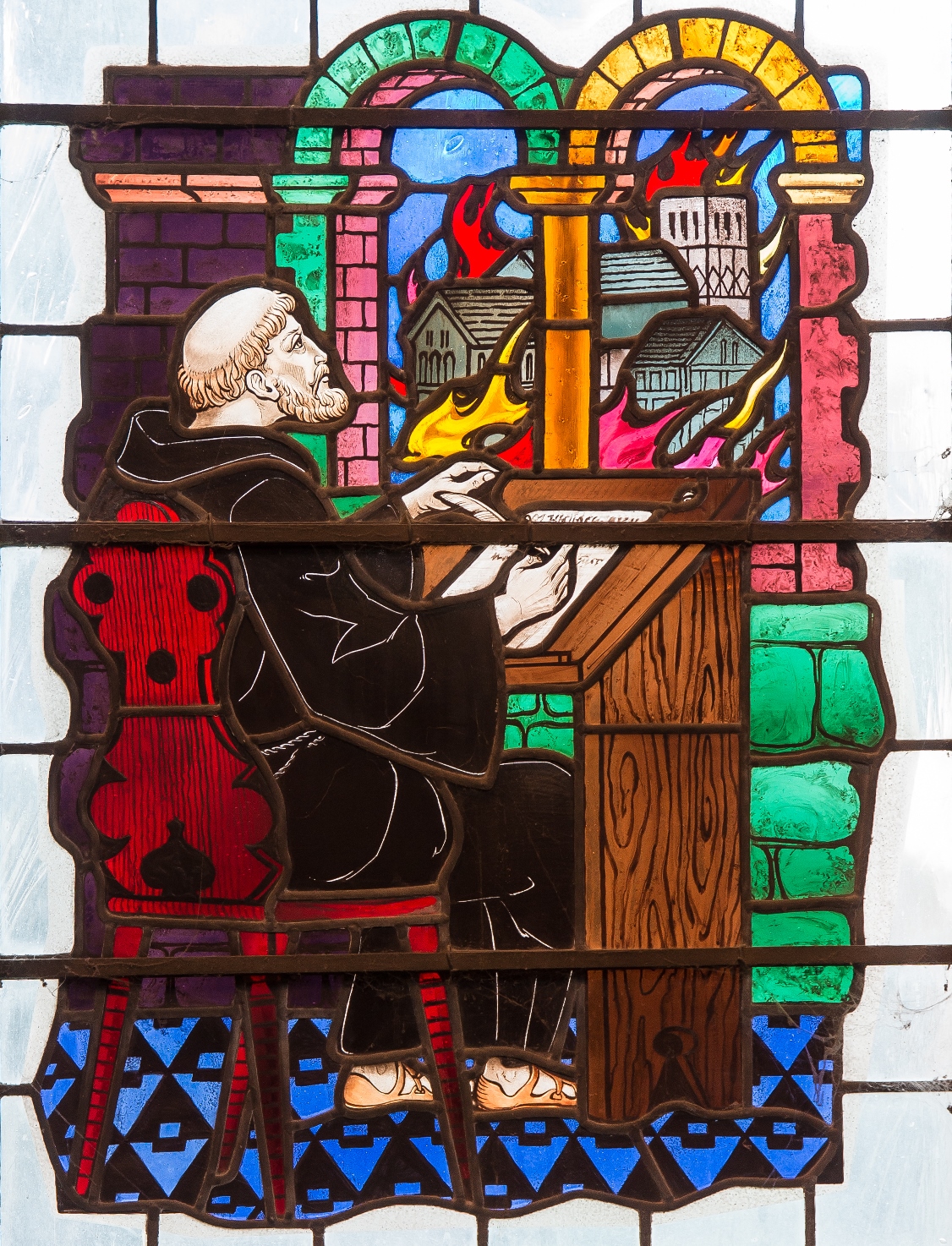 1116 – A fire breaks out, destroying much of the monastery and town, seemingly from an unattended fire in a bakery. The Anglo-Saxon Chronicle says “all the minster of Peterborough burned, and all the buildings except the chapter-house and the dormitory; and besides, the most part of the town also all burned. All this happened on a Friday; that was 4 August…”
1116 – A fire breaks out, destroying much of the monastery and town, seemingly from an unattended fire in a bakery. The Anglo-Saxon Chronicle says “all the minster of Peterborough burned, and all the buildings except the chapter-house and the dormitory; and besides, the most part of the town also all burned. All this happened on a Friday; that was 4 August…”
Much of the Anglo-Saxon Chronicle, our key source for early medieval English history, is written at Peterborough Abbey in this period.
1118 – The replacement monastic church – the present Cathedral building - is begun.
1143 – King Stephen visits and stays at the monastery, granting a market charter
c.1150 – In order to bankroll the building of the new monastic church, Abbot Martin de Bec creates a new market area to the west of the monastic precincts. The monks create new commercial streets around the outside, leading to the first ‘new town’ development in Peterborough and effectively the street plan which still exists as the city centre today.
1154 – King Henry II visits, with his Chancellor, Thomas Becket.
1174-77 – Construction of the Becket Chapel and adjacent hospital to house many of the monastery’s holy relics, not least the relics of the newly canonised St Thomas Becket.
1216 – King John stays at the monastery, using it as a base of operations to attack his enemies in the region. He may have left a draft copy of Magna Carta here, hence the inclusion of one in one of the monastery’s cartularies, known today as ‘the Black Book of Peterborough’.
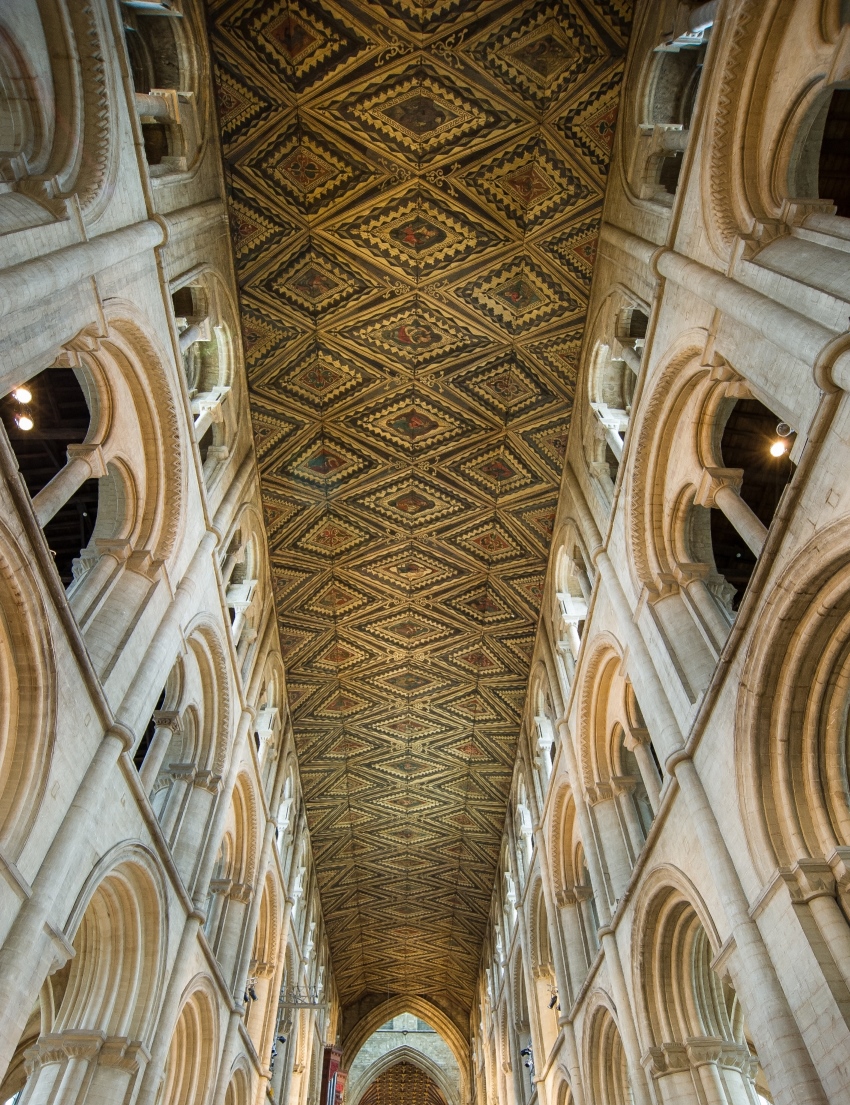 1238 – The new monastic church is consecrated in 1238 and the structure of the building remains essentially as it was on completion. Most significantly the original wooden ceiling survives in the nave, the only one of its type in this country and one of only four wooden ceilings of this period surviving in the whole of Europe, having been completed between 1230 and 1250. It has been over-painted twice, but retains its original style and pattern.
1238 – The new monastic church is consecrated in 1238 and the structure of the building remains essentially as it was on completion. Most significantly the original wooden ceiling survives in the nave, the only one of its type in this country and one of only four wooden ceilings of this period surviving in the whole of Europe, having been completed between 1230 and 1250. It has been over-painted twice, but retains its original style and pattern.
1268 – King Henry III visits, granting the rights for a town fair.
1272-1286 – The Lady Chapel is added to the north side of the monastic church. This would later be pulled down during the Civil War.
c.1300 – A solar tower is added to the manor at Longthorpe, owned by the Thorpe Family, who acted as land agents and stewards to the monastery at Peterborough. The tower is decorated with wall paintings dating between 1320 and 1340, possibly painted by monastic artists, and still survives today as the finest 14th century domestic wall paintings in Northern Europe.
1302 – King Edward I visits and stays for several days, costing the monastery £245 to feed him and his entourage.
1307 – The monks commission a bridge across the river Nene, the first ‘Town Bridge’ which still has a construction on the same site today. This had to be replaced the following year due to shoddy building work, but then survived into the 19th century.
1308 – A ‘licence to crenellate’ is granted allowing the main monastic gateway and King’s Lodging (the ‘Norman Arch’) to be strengthened and fortified.
1314 – King Edward II stays at the monastery en route with an army bound for Scotland, to be defeated at the Battle of Bannockburn. He had previously visited as Prince of Wales with his favourite, Piers Gaveston.
1327 – King Edward III spends Easter at the monastery. He visits annually between 1332 and 1336.
1337 – Edward the Black Prince spends the summer staying at the monastery.
1349 – The Black Death hits Peterborough. Approximately a third of the townspeople and 32 of the 64 monks at the monastery perish.
c.1370 - Alterations to the central tower of the monastic church take place. The main beams and roof bosses of the tower date back to the 1370s.
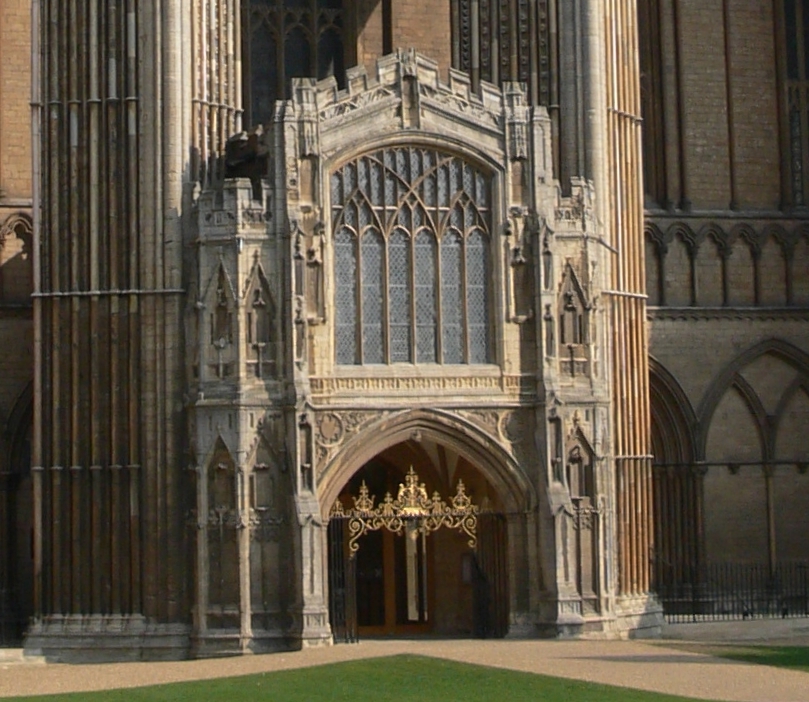 1375 – Galilee Porch added to the west front of the Cathedral
1375 – Galilee Porch added to the west front of the Cathedral
1381 – An assault is made on the monastery by local rebels during the Peasant’s Revolt. The rebels are put down by the intervention of troops commanded by the Bishop of Norwich,
1392 – Birth of Blanche, daughter of the future King Henry IV at the monastery.
1394 – Birth of Philippa, daughter of the future King Henry IV at the monastery. Philippa grew up to become Queen of Denmark.
1402 – Abbots of Peterborough become ‘Mitred Abbots’ with all the powers of a Bishop.
1452 – King Henry VI visits the monastery on pilgrimage.
1461 – The monastery and town are sacked by a Lancastrian army led by Queen Margaret of Anjou during the Wars of the Roses. The monastery was in the orbit of Fotheringhay Castle, the main seat of the House of York. Both the future Edward IV and Richard III would have visited the monastery as children.
1486 – King Henry VII visits the monastery.
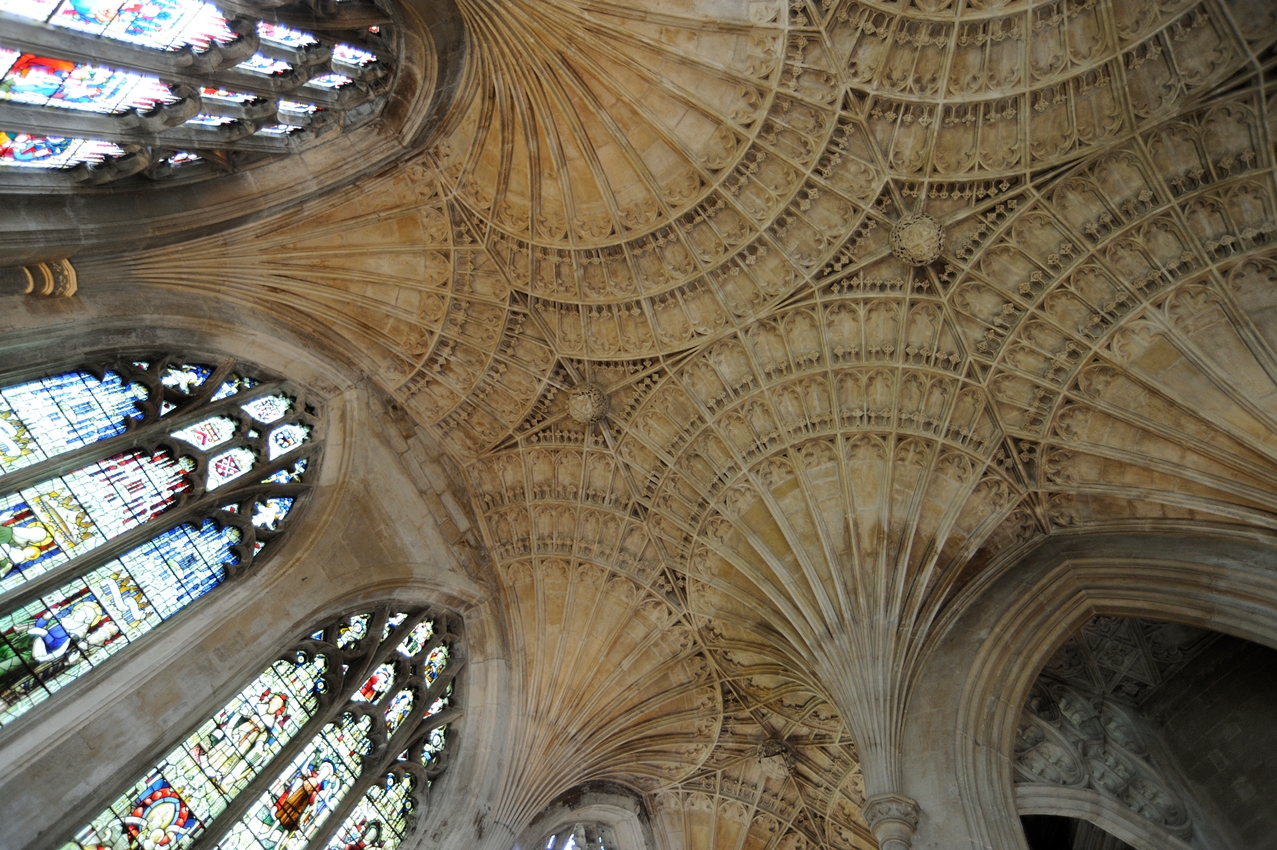 1496 - 1509 - The Presbytery roof is renewed and an extensive building programme undertaken at the east end creating the 'New Building', an excellent example of late Perpendicular work with fine fan vaulting probably designed by John Wastell, who went on to work on King's College Chapel in Cambridge.
1496 - 1509 - The Presbytery roof is renewed and an extensive building programme undertaken at the east end creating the 'New Building', an excellent example of late Perpendicular work with fine fan vaulting probably designed by John Wastell, who went on to work on King's College Chapel in Cambridge.
c.1510 – Abbot Kirkton is said to have confiscated land on Boongate, part of the northern burial ground, and other property to create a deer park.
1530 – Having fallen from favour with King Henry VIII, Cardinal Wolsey celebrates Easter at the monastery on his way north into exile.
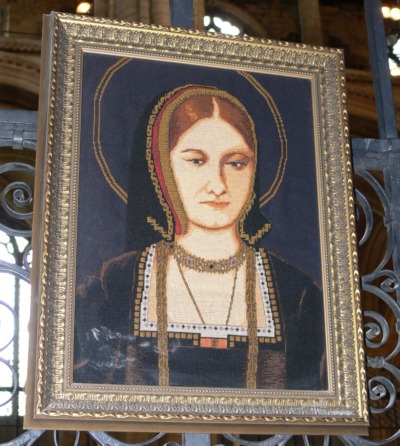 1536 – Katharine of Aragon, first wife and queen of Henry VIII, is buried in the monastic church.
1536 – Katharine of Aragon, first wife and queen of Henry VIII, is buried in the monastic church.
Read more about Katharine of Aragon.
1539 - The great abbey of Peterborough was closed and its lands and properties confiscated by the king.
1541 - To increase his control over the church in this area Henry VIII created a new bishop (the former abbot, John Chambers) and Peterborough Abbey church became a Cathedral. The foundation charter of the Cathedral, formally established on 4 September 1541, constituted a chapter of a dean (appointed by the crown) and six canons. In addition the charter established six minor canons, a deacon, sub-deacon, eight singing men, and eight choristers, two schoolmasters serving 20 scholars and six almsmen. In 1541 the prebends were each valued at £20 (£7 unless resident) and the deanery at £100; taking account of fines and renewals in the 1720s canons could expect an annual income of between £49 and £281.
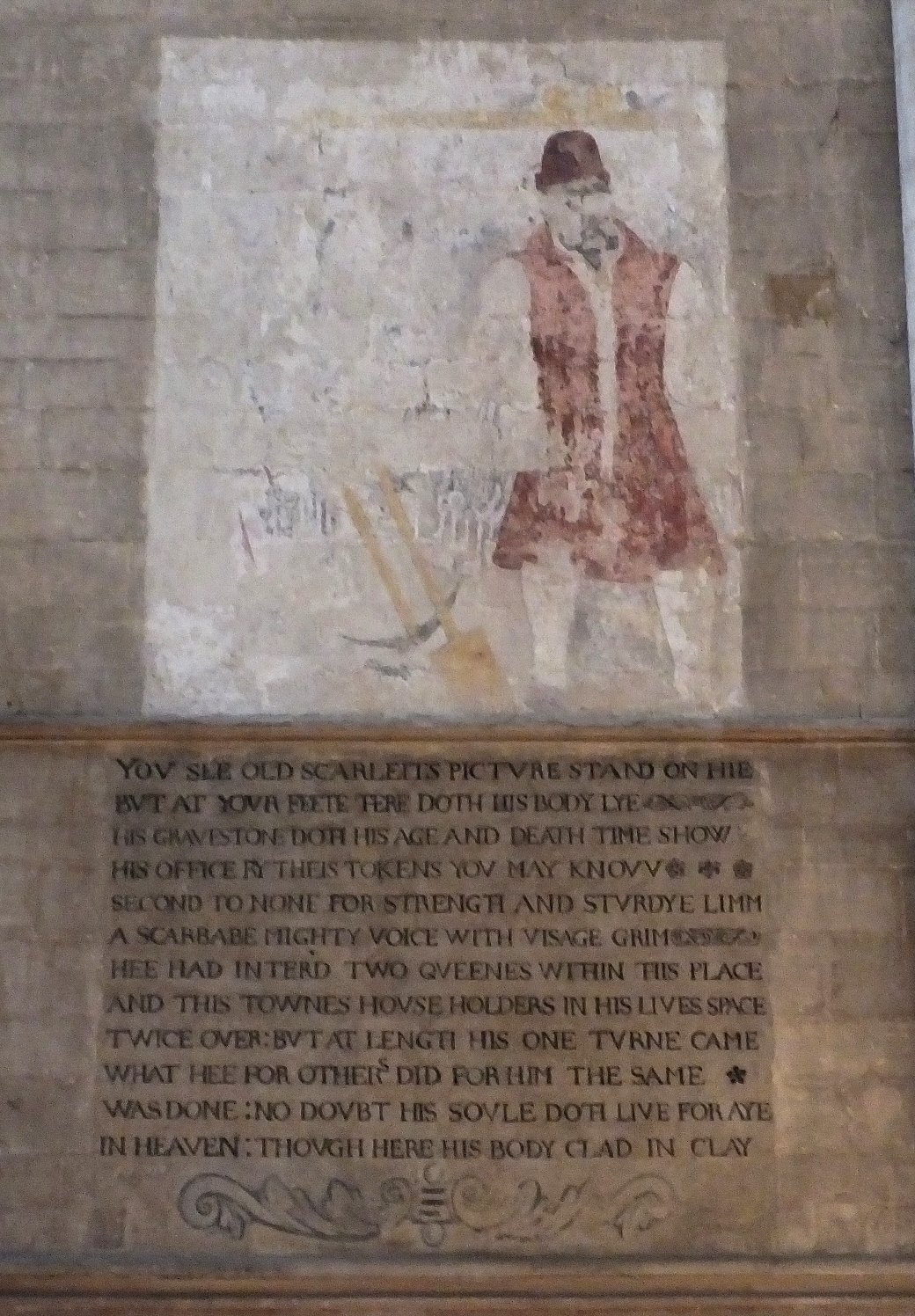 Henry also created a grammar school in the Precincts, the foundation of the King’s School.
Henry also created a grammar school in the Precincts, the foundation of the King’s School.
1587 – Mary, Queen of Scots is buried in the Cathedral in August, 5 months after having been executed at nearby Fotheringhay Castle. The Dean, Richard Fletcher, officiated at both her execution and her funeral. Read more about Mary, Queen of Scots
1594 – Robert Scarlett, ‘Old Scarlett’, the parish Sexton dies at the age of 98. He is buried just inside the Cathedral and commemorated with a painting and rhyme above the west doors.
1613 – First performance of Shakespeare’s ‘Henry VIII’ in London, co-written with John Fletcher. Fletcher was a King’s schoolboy and the son of Dean Richard Fletcher.
1643 - The Cathedral was ravaged during the English Civil War when Peterborough, a town with Royalist sympathies, was taken by Colonel Oliver Cromwell. Nearly all the stained glass was destroyed and the altar and reredos, cloisters and Lady Chapel were demolished. Much of the Cathedral’s library was destroyed by Cromwell’s troops by being burnt in the cloisters. The Royalist newsbook ‘Mercurius Aulicus’ describes it thus:
‘It was advertised this day from Peterburgh, that Colonell Cromwell had bestowed a visit on that little City, and put them to the charge of his entertainment, plundering a great part thereof to discharge the reckoning, and further that in pursuance of the thorow Reformation, he did most miserably deface the Cathedrall Church, breake downe the Organs, and destroy the glasse windowes, committing many other outrages on the house of God which were not acted by the Gothes in the sack of Rome, and are most commonly forborn by the Turks when they possesse themselves by force of a Christian city.’
1646 – King Charles I is briefly imprisoned for 2 nights in the Precincts by Parliamentary troops on route to Holdenby House in Northamptonshire.
1653-4 – Much of the stonework from the ruined monastic buildings is quarried away and used for building Thorpe Hall, the new property for local magnate and Lord Chief Justice Oliver St John. John Evelyn describes Thorpe Hall as ‘a stately palace… built out of the ruins of the Bishop’s palace and cloisters. A recent archaeological survey at Thorpe Hall has confirmed the usage of monastic stonework.
1666 – Last visitation of the plague on Peterborough. The Cathedral clergy flee the city to avoid infection, leaving St John’s parish priest Symon Gunton to bury about a third of his parishoners.
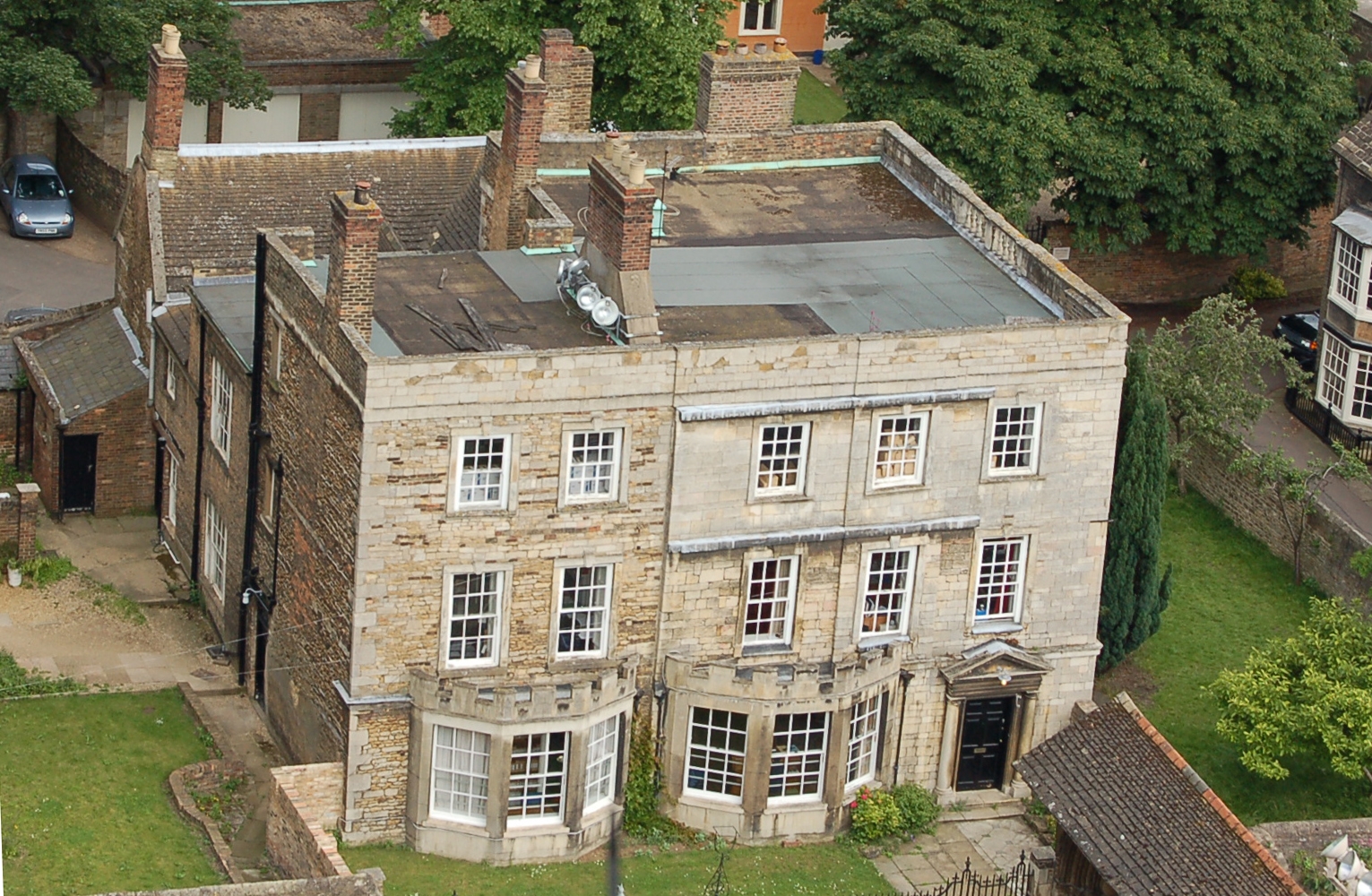 c.1690 – Laurel Court is first built, and then extended, most likely in the 1720s. Initially it is the Precentor’s house, then used as the Deanery for much of the 1700s.
c.1690 – Laurel Court is first built, and then extended, most likely in the 1720s. Initially it is the Precentor’s house, then used as the Deanery for much of the 1700s.
1822-30 – Much of the damage done during the Civil War is gradually repaired, particularly a major restoration undertaken under the leadership of James Henry Monk as Dean. Much of this work would later be undone with the 1880s restoration.
1837-8 - An order-in-council of 1837 reduced the number of prebends in the cathedral to four, one of which from 1838 was annexed to the Archdeaconry of Northampton.
1870 – A Girl’s School is established in Laurel Court, by the redoubtable Miss Margaret Gibson, and remains open until 1928. Edith Cavell attends the school as a pupil-teacher 1885-6.
1880s - The Central tower was rebuilt for a second time and after this the whole central and eastern area of the church required refurbishment. This provided an opportunity for the creation of the fine, hand carved choir stalls, cathedra (bishop's throne) and choir pulpit, and the marble pavement and high altar.
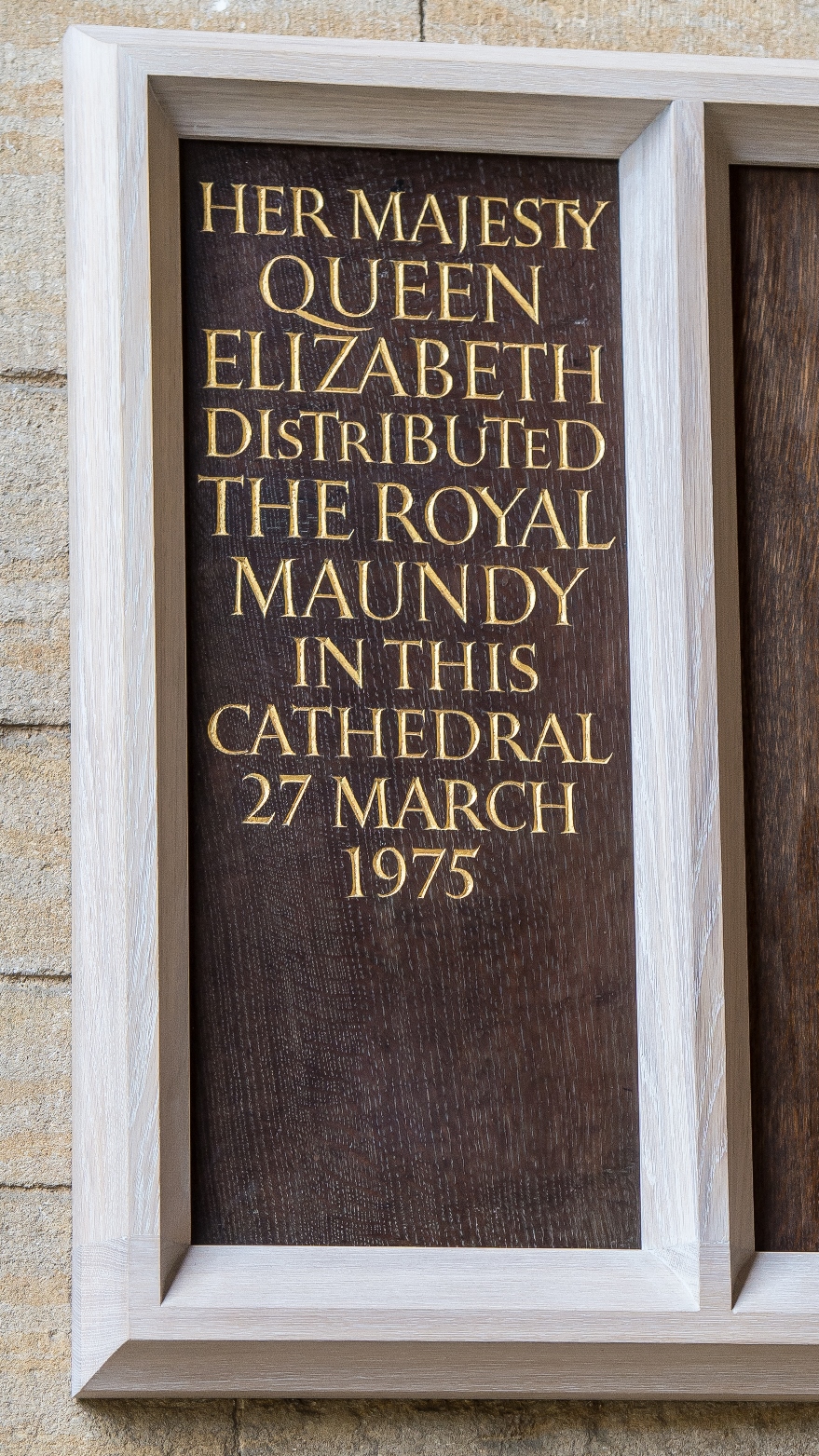 1885 – The King’s School moves from the Precincts to its current location on Park Road.
1885 – The King’s School moves from the Precincts to its current location on Park Road.
1895 – Tomb of Katharine of Aragon restored thanks to an appeal led by Katharine Clayton.
1941 and 1944 – Air raids on the city causes significant damage. The Cathedral suffers only minor damage thanks to work from a dedicated team of fire watchers.
1975 – Queen Elizabeth II gives Maundy Money at the Cathedral.
2001 – A substantial fire breaks out in the South Transept, after which a major restoration project takes place.
Today - In the 21st century the Cathedral still follows its traditional pattern of daily worship, as well as serving as a vibrant and developing community with outreach and education programmes, and performances and civic events.